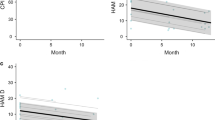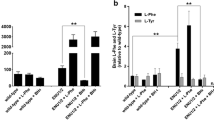Abstract
Thirty years ago it was observed that the synthesis of serotonin, dopamine and norepinephrine was impaired in untreated phenylketonuria (PKU) as judged either by a decreased concentration in the blood or decreased excretion in the urine of these neurotransmitters, or of their meta10545tes, 5-hydroxyindoleacetic acid (5-HIAA) and homovanillic acid (HVA). Fifteen years later, when early treatment of PKU with a phenylalanine restricted diet was routinely introduced, an inverse relationship was found between phenylalanine levels and the urinary excretion of dopamine and serotonin. An inverse relationship between blood phenylalanine levels and cerebrospinal fluid (CSF) concentrations of HVA and 5-HIAA has repeatedly been reported during the past 10 years. Recently, the effect of the discontinuation of diet in PKU on the synthesis of dopamine, norepinephrine and serotonin has been examined, and the possible relationship between low levels of these neurotransmitters and impaired performance on neuropsychological tests has been evaluated. In some PKU patients the performance on neuropsychological tests of higher integrative function is impaired after discontinuation of diet, especially when blood phenylalanine values exceed 1200 µmol/L, and the patients often complain of lack of concentration and emotional instability. When these patients return to a ‘relaxed’ phenyalanine restricted, tyrosine enriched diet, the impaired neuropsychological and behavioural functions appear to be reversible. One mechanism may involve an impaired synthesis of dopamine and serotonin, as the improvement is accompanied by an increase in dopamine and serotonin excretion and a significant increase in CSF concentrations of HVA and 5-HIAA. Quite recently it has been observed that supplementation of a free diet with tyrosine (approximately 150 mg/kg) seemed to improve personality, behaviour, reaction time or reaction time variability in patients off diet. Plasma tyrosine and CSF HVA concentrations increased significantly. Plasma phenylalanine levels remained high (>1200 µmol/L). Supplementation of a normal diet with tyrosine and tryptophan may prevent mental and neuropsychological dysfunction following diet discontinuation in PKU.
Similar content being viewed by others
References
Armstrong, M. D. and Robinson, K. S. On the excretion of indole derivatives in phenyl-ketonuria.Arch. Biochem. 52 (1954) 287–288
Berry, H. K., Bofinger, M. K., Melanie, M. H., Philips, P. J. and Guilfoile, M. B. Reduction of cerebrospinal fluid phenylalanine after oral administration of valine, isoleucine, and leucine.Pediatr. Res. 16 (1982) 751–755
Brunner, R. L., Jordan, M. K. and Berry, H. K. Early treated phenylketonuria: neuropsychologic consequences.J. Pediatr. 102 (1983) 831–835
Butler, L. J., O'Flynn, M. E., Seifert, W. E. and Howell, R. R. Neurotransmitter defects and treatment of disorders of hyperphenylalaninemia.J. Pediatr. 98 (1981) 729–733
Curtius, H. C., Vollmin, J. A. and Baerlocher, K. The use of deuterated phenylalanine for the elucidation of the phenylalanine-tyrosine meta10545sm.Clin. Chim. Acta 37 (1972) 277–285
Curtius, H. C., Wiederwieser, A., Viscontini, M., Leimbacher, W., Wegman, H., Blehova, B, Rey, F., Schaut, J. and Schmidt, H. Serotonin and dopamine synthesis in phenylketonuria.Adv. Exp. Med. Biol. 133 (1981) 277–291
Katz, I., Lloyd, R. and Kaufman, S. Studies on phenylalanine and tyrosine hydroxylation by rat brain tyrosine hydroxylase.Biochem. Biophys. Acta 445 (1976) 567–578
Krause, W., Halminski, M., McDonald, L., Dembure, P., Salvo, R., Freides, D. and Elsas, L. Biochemical and neuropsychological effects of elevated plasma phenylalanine in patients with treated phenylketonuria.J. Clin. Invest. 75 (1985) 40–48
Lou, H. C. Large doses of tryptophan and tyrosine as potential therapeutical alternative to dietary phenylalanine restriction in phenylketonuria.Lancet 1 (1985) 151
Lou, H. C., Güttler, F., Lykkelund, C., Bruhn, P. and Neiderweiser. A. Decreased vigilance and neurotransmitter synthesis after discontinuation of dietary treatment for phenylketonuria in adolescents.Eur. J. Pediatr. 144 (1985) 17–20
Lovenberg, W., Jéquier, E. and Sjoerdsma, A. Tryptophan hydroxylation in mammalian systems.Adv. Pharmacol. 6A (1968) 21–35
McKean, C. M. The effects of high phenylalanine concentrations on serotonin and catecholamine meta10545sm in the human brain.Brain Res. 47 (1972) 469–476
McSwigan, J. D., Vorhees, C. V., Brunner, R. L., Butcher, R. E. and Berry, H. K. Amelioration of maze deficits from induced hyperphenylalaninemia in adult rats using valine, isoleucine, and leucine.Behav. Neur. Biology 33 (1981) 378–384
Nadler, H. L. and Hsia, D. Y. Y. Epinephrine meta10545sm in phenylketonuria.Proc. Soc. Exp. Biol. Med. 107 (1961) 721–722
Paere, C. M., Sandler, M. and Stacey, R. S. Decreased 5-hydroxytryptamine deficiency in phenylketonuria.Lancet 1 (1957) 551–553
Paere, C. M., Sandler, M. and Stacey, R. S. Decreased 5-hydroxytryptophan decarboxylase activity in phenylketonuria.Lancet 2 (1958) 1099–1101
Peterson, N. A., Shah, S. N., Raghupathy, E. and Riioads, R. Presynaptic tyrosine availability in the phenylketonuric brain: a hypothetical evaluation.Brain Res. 272 (1983) 189–193
Pratt, O. E. Transport inhibition in the pathology of phenylketonuria and other inherited meta10545c diseases.J. Inher. Metab. Dis. 5 Suppl. 2 (1982) 75–81
Sandler, M. Inborn errors and disturbances of central neurotransmission (with special reference to phenylketonuria).J. Inher. Metab. Dis. 5 Suppl. 2 (1982) 65–70
Tong, J. H. and Kaufman, S. Tryptophan hydroxylase: purification and some properties of the enzyme from rabbit hindbrain.J. Biol. Chem. 250 (1975) 4152–4158
Udenfriend, S. The primary enzymatic defect in phenylketonuria and how it may influence the central nervous system. In Anderson, J. A. and Swaiman, K. F. (eds).Phenylketonuria and Allied Meta10545c Diseases. Dept. of Health, Education and Welfare, Washington DC, 1967, pp. 1–8
Waisbren, S. E., Schnell, R. R. and Levy, H. L. Diet termination in children with PKU. A review of psychological assessments used to determine outcome.J. Inher. Metab. Dis. 3 (1980) 149–153
Weil-Malherbe. Blood adrenaline and intelligence.J. Ment. Sci. 101 (1955) 733–745
Author information
Authors and Affiliations
Rights and permissions
About this article
Cite this article
Güttler, F., Lou, H. Dietary problems of phenylketonuria: Effect on CNS transmitters and their possible role in behaviour and neuropsychological function. J Inherit Metab Dis 9 (Suppl 2), 169–177 (1986). https://doi.org/10.1007/BF01799701
Issue Date:
DOI: https://doi.org/10.1007/BF01799701




